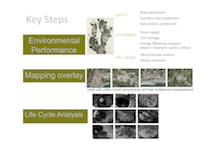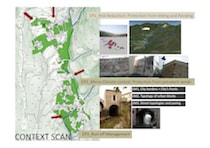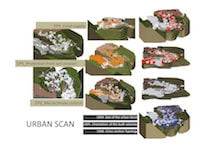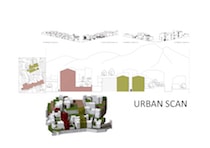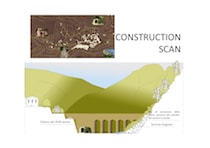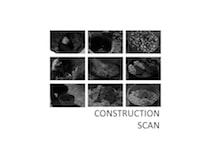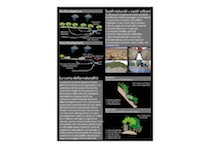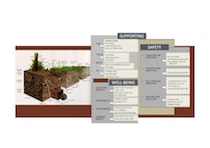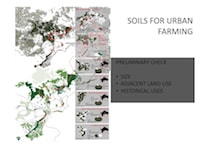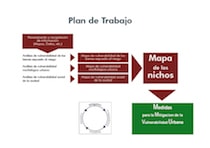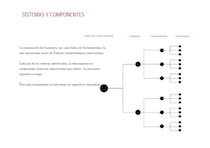Il rapporto tra Sostenibilità e Innovazione tecnologica nella progettazione dell’ambiente urbano a cura di Filippo Angelucci
torna su
Vulnerability and Resilience of Urban Environment
Marina Rigillo
Marina Rigillo
Abstract:
The paper discusses a five years experience by researchers from the Architecture Department (DiARC) and from the Research National Council (CNR-Irat) on the topic of urban vulnerability and urban resilience. The article starts from the cultural background of the research unit and focuses on the topics of resilience and vulnerability applied to the urban environment, stressing the interplay between the building environment and the Eco-system services. Besides the paper deals with the on going research of the “Estudio de la Amenaza Sísmica y Vulnerabilidad Física del Gran Santo Domingo” – developed in the framework of the EU Aid programme and supported by UNDP – and the initiative “41°Parallel” developed with the support of the N.Y. firm LOT-EK Studio and the N.Y. Waterfront Alliance
Key words:
Ecological approach
Integrated project
Vulnerability
Adaptability
Governance
From Sustainability to Resilience
The paper discusses a five years research done by technologists (DiARC) and planners (CNR-Irat), coming from different research experiences and from different academic fields, that put together expertises and know-how for developing research methodologies in the field of urban sustainable development. In such framework the specific research issues concern the following topics: the climate change risk, the vulnerability of the urban asset, the resilience potential of the city (and the coping capacity of its inhabitants), the ecological efficiency of the urban form.
The cultural assumption posits that urban environment is a complex ecosystem, characterized by a wide set of features (its history, the architecture of the city, the natural environment and its micro-climate, the city land use, its social and economic dynamics) that define city’s identity and the specific range of its transformability through a new design perspective, founded on integrated projects and multi-scale approach. In this perspective, the description of the urban space becomes a key issue for governing project complexity. Defining a knowledge-oriented methodology aimed at implementing technological systems and the specific project values is a key step for applying the resilience principles of adaptability and re-design as transposed into the project process. We are not speaking here of mere analogy, the replacement of the word “sustainability” with a new one, less used, but we face a cultural revolution in terms of project potential, giving effectiveness to the concept of "urban carrying capacity" as real opportunity for a new design approach that works on the project specific aptitudes at forecasting urban settings, including in it (and governing) the changing dynamics, instead of merely implementing its resisting capacity.
In this framework, the insertion of the resilience paradigm into the sustainable urban design is a crucial innovation that provides new cultural terms for the discussion about project methodologies and objectives. The need of adequate, holistic, knowledge of the urban environment is pointed out. Interest is given to methods for producing systemic and structured knowledge, able at updating scientific positions on the topic of human-nature relationship. It is an innovative, cultural contribution to forecast (and to manage) urban changes, developing mutual adaptations between built and natural environments by the aim of governing its complexity. We specially refer to the main drivers of urban change such as global warming, global economy, the spreading out of digital technologies that lead to the continuous reset of the urban needs and of the specific socio-economic values connected to. It means that – also at local level – the inclusion of the resilience paradigm in urban planning requires the trial of integrated projects and of specific measures for acting in the perspective of risk pro-active management (City of Tomoroww, 2011).
The project of the urban environment becomes, indeed, a sort of prime strategy for responding to the double requirement of adaptability and transformability of the built environment. Such cultural innovation represents a new, strategic hub for achieving sustainability, also implementing new methodological tools and operative devices for supporting decision process at multiple scales. Starting from the resilience definition as «the capacity of a system to absorb disturbance and reorganize while undergoing change so as to still retain essentially the same function, structure, identity, and feedbacks» (Walker et al., 2004), it is possible to appreciate a crucial change for the project potential that turns to be the prime cultural tool for supporting urban carrying capacity, adapting urban forms and urban performances to the more sophisticated uses of the city space and to the needs of human well-being. Urban project has been re-set as more pragmatic tool, aimed at merging urban change with new forms of living the city as well as the new environmental condition of the global society, also considering the social demand of development opportunities and of new jobs.
In the perspective of resilience upgrade, the need of safeguarding the existing natural assets is not more cultural dogma, but common goal that has to be continuously discussed and ri-negotiated according to the specific demand of uses, to the local identity and the city history. The scientific community turns reflecting on the relationship between man and nature, reading the term “transformability” through new and former requirements: durability, intended as the capacity of maintaining performances, according to self-regenerative processes; the skills of the urban form, according to the risk potential; the flexibility of the city space use, according to the adaptive cycles of the urban environment: «Pour durer, un objet abritant une activité humaine aussi instable, doit être transformable: c’est l’enfance de la logique du durable […] La transformabilité doit être incorporée visiblement aux formes d’architecture» (Kroll, 2011).
In this sense, the concept of resilience implements and modifies partially the requirements of the sustainable urban form as we found in literature (Jabareen, 2006). The environmental project plays a new role as engine of adaptability and/ or transformability process and it points out the importance of the urban form and its architecture, giving scientific evidence to the need of approaching new – and resilient - design method working on the relationship between exigency and performance, by which responding to the demand of improving the ecological efficiency of the human habitat (Angelucci, De Sivo & Ladiana, 2013). The concept of performance is here considered as positive, active tool of the project; performance intended as original knowledge outcome of the uniqueness of the urban context, made by the mix of built and natural environments, of the social demand and of economic interests. Starting by the new definition of performance, scholars renovate the interest to the “appropriate technology” (Gangemi, 1988) as indicators of the project resiliency potential1; performance is also considered as local value, product by the site history, fit to develop viable project scenarios that have to be monitored through indicators.
Scenarios that respond to the “culture of limits”, as defined by Salvatore Dierna that with visionary anticipation described the functional and semantic correspondence between the project and the site specific, essential cultural constraint for developing mutual relationship of adaptability between built environment and natural cycles: «the Modern Condition as (collective) project could lead toward technological systems that are intermediates, multivariate, flexible in the way of responding at the real demand in terms of quantity and/ or quality; (technological systems) able at (minimizing) the use of resources, integrating the recovery of the traditional techniques with powerful, innovative construction processes. (The Culture of Limits) could combine the modern technological potential with the care of the environment and the historical identity of the place, working through the addition of minor actions, of tentative options, through the systematic care of the local cultural models» (Dierna,1994).
The Ecological Approach to the Project of the Urban Space
Starting from the resilience cultural background, the research unit Diarc-CNR oriented its work toward the topic of redevelopment through life cycle basedproject approach. Interest is given to the urban open space as essential space of connectivity of the city life, the place where it is possible to understand the urban stratigraphy and the common background of the city users, the role of the city economy and the relationship between citizen and their built environment (Gregotti, 2011). Urban open space is also natural space and space for testing technological innovation and social cohesion (Gehl, 1987; Carmona et al., 2003; Palazzo & Steiner, 2011). The research unit gives special importance to the cities ecology potential2, using the term “ecology” according to its widest meaning, mainly referring to its Greek origin, the word οίκος (the relationships that take together living species with biotic and a-biotic factors, in a certain space). Further the research assumes the dynamic flows featuring natural and anthropogenic processes as part of the project, thinking over the cycles of energy, material, information and the urban space itself as components of the cities resilience (Odum, 1973)3. The study aims at overcoming the dualistic approach between human and nature for achieving the cultural consciousness of the consistency of the urban space with the natural environment according to the increasing attraction of the cities as place to live, engine of innovation, development, creativity (UNDP 2011, Cities of Tomorrow, 2011).
In this perspective, working through the ecological approach leads to consider the inner relationship of the urban space as integrated system, therefore it aims at orienting project methodologies toward a set of requirements fit to face the global changes and to enhance the identity of the local context. Natural resources in the city environment become the prime components of the city project, vibrant and dynamic factors for testing the spatial arrangement of urban forms consistent both with the changed demand of using spaces in the city and with the capacity of activating adaptability processes in the urban environment. In the same way, the a-biotic, massive part of the city environment participates of the construction of the urban habitats, even providing the traditional living functions extended to the safeguarding of the natural environment and biodiversity in cities4. City is considered «as complex, adaptive socio-ecological systems in which the delivery of eco system services links society and ecosystems at multiple scales» (Grimm et al, 2008, pp.756), according to the vision proposed by Kevin Lynch in its theory of good city form that represents the cultural root of the advances in human-nature relationship as developed by scholars working in the field of urban ecology. In the 1981, indeed, Kevin Lynch illustrated the natural potential of the cities through the analysis of the dimension performance of Vitality, described as «the degree by which the form supports vital functions, the ecological requirements and the capacity of sustaining human beings» (Lynch, 1981, pp. 122), giving scientific evidence to the subsidiary function of green areas in the cities in terms of production, safety and well-being. The Lynch vision anticipates the scientific advances in assessing the comprehensive value of the ecosystem services in the city (even the economic one) (Costanza 1997; TEEB 2010; De Groot; 2012) and the concept of resilience as new cultural driver of the city project (MEA, 2005)
Vulnerability and Resilience of Urban Environment. Research Experiences
The position of the research unit DiARC-CNR is featured by the academic specific of the members’ curricola and it is oriented to explore the relationship between vulnerability and resilience in the urban environment, according to the differences coming from the scale of the project and from the thematism adopted5. Interest has given first to the inner sustainability of the ancient cities (2010-2012) by the aim of inquiring the adaptive capacity of those old settlements at local environmental constraints, even focusing on the resource availability and on the risk potential. The study sort out some old settlements in Southern Italy engendered by spontaneous processes that represent a good examples of harmonization with landscape, featured by its strong adaptation to the site (Turri, 1979). The research aims at inquiring the consistency between natural environment and urban form, looking at the original marks of the place as signs of the historic anthropogenic symbiosis in which human needs – and its social and economic systems – have been integrated in the soil use. The field research demonstrated the deep correspondence between typological patterns and local climate, as well as the relationship between the constructive system (even consistent with the availability of raw materials) and the life cycle of the technical elements of the building (Fig. 1.).
The study is aimed at providing an effective methodology for sounding out the construction process of the urban settlement and its sustainability through a set of indicators related to the urban form at different scales: the urban patterns, the shape of the urban block and of the building typologies, the façade treatments, the construction system, the use of raw material and their relationship both with the material cycles and the stock renewal capacity (Fig. 2). The empiric findings of the field work done support the existence of inner (and somehow implicit) requirement of ecological efficiency of the urban form aimed at providing a set of environmental performance to fit the main human needs (sustenance, safety and well-being). Such performances are consistent with the need of using the urban form for regulating the micro-climate variation, for managing run-off, for reducing the environmental risk potential improving on the resilience of the urban settlement (Rigillo et al. 2012). The methodology was applied to three case studies: the municipalities of Giffoni Sei Casali (Fig. 3.), Cava de’ Tirreni (Fig. 4.), Vietri. The comparison of results allows us to state that the morphological history of the place is a key element for assessing the resilience of the urban environment at local level. This kind of sound knowledge is the learnt lesson for developing the concept of “transformability” in terms of performances required, steering the project toward technical solution consistent with natural constraints - fit to the decision makers wills - and adequate to reduce the comprehensive vulnerability of the urban system6 (Fig. 5., Fig. 6.).
Based on the achieved results, one more research line has been developed on the topic of the environmental performances, moving the conceptual definition of performance from the field of building construction to that of urban space. Despite performance definition is complete and updated in literature on building construction, it is not the same for the urban space where the term is mainly oriented to explicate the needs of management certification of productive sites (ISO 14001, ISO 14015, ISO 14031).
The importance of urban soil for the upgrading of the cities' quality of living has been definitively demonstrate by the studies of urban ecology and by the work of Millennium Ecosystem Assessment (2005), so that urban soil can be used as empiric indicator of a number of urban environmental performances. By the soil – and specially by the evopranspiring ones – a range of essential ecosystem services have provided, such as the production of food and oxygen, the CO2 storage, the urban biodiversity and the run-off management, the reduction of risks (sliding risk, flooding, fire, pollution) and the inhabitants well-being (Fig. 8.). Starting from these assumptions, the DiARC-CNR research deepens the interplay between ecosystem cycles and urban form by the aim of extending the concept of performance to the all services produced by the city environment, also integrating such performances with the social demand and economic cycles.
In this perspective, the topic of technological innovation has been developed working on the recovery of impervious surfaces in new soils, artificial and evotranspiring, designed for responding to the social and ecological demand of upgrading the urban services and of projecting more resilient urban space as well (Fig. 9.). This approach offer the opportunity of testing spatial and technological solution focused on the requirement of environmental performances, designed for being fit to the comprehensive capacity of the urban system, even considering the needs of its effective management and of economic benefits: «The metabolism of cities is largely the result of the concentration of people and economic processes. It is also related to the urban form» (Pauleit et Breuste, 2011 pp.19).
The third research line is aimed at developing decision support systems, using the field work done in Santo Domingo, Dominican Republic. The research unit is now working in partnership with the United Nation (UNDP) and the European Union (EU) on the topic of the proactive management of the seismic risk8. The DiARC-CNR commitment is to deepen the topic of the urban vulnerability and to propose planning strategies for facing seismic risk and improving urban resilience. The specific aim of the job is to tailor projects and measures for reducing urban vulnerability in case of earthquake and for implementing the coping capacity of the city as well. The Dominican Republic occupies indeed part of the Hispaniola Island, shocked by the earthquake that destroyed the city of Port aux Prince, Haiti, in 2010 and it has also registered one of the most destructive earthquake of the history (1946, magnitude 8.1). Santo Domingo is also interested by immigration flows coming both from the rural areas and Haiti Republic. Further, Santo Domingo is interested by immigration flows coming both from the rural areas and Haiti Republic. Such flows have implement the need of residential areas and have caused the massive soil loss in suburb area (also creating slums) and a change in housing typologies: new floors have been added to the existing buildings and the comprehensive construction quality has been downgraded due to the employment of not skilled workers or because of auto-construction process9.
In the first year of the project, the contribution of the research unit was aimed at producing a GIS inventory designed for assessing the urban comprehensive vulnerability (Fig.10a.), working on the following systems:
- the exposure of urban assets, assessing first the human lives and, and then the presence of built and natural assets, specially considering the historical and cultural heritage of the city and the existing urban infrastructures and nets;
- the urban morphology, as additional vulnerability factor in terms of suitability to access to safe places in case of seismic event;
- the social vulnerability as indicator of the comprehensive coping capacity.
For each system, a tree shaped model was structured in a way of organizing the set of indicators that represent the three different components (Fig. 10b). These indicators have been spatialized in a set of thematic layers and overlaid according to the before mentioned vulnerability systems so that three different vulnerability maps have carried out. The mapping overlay of the three vulnerability systems was implemented by the evaluation through the pairwise comparision method (Saaty 2005) by which one more map was carried out as representative of the most vulnerable urban clusters in Santo Domingo (Rigillo & Cervelli, 2014). Within those clusters twenty-three (23) special buildings have sorted out (hospitals, police stations, fire stations, governative buildings etc.).
These buildings are a key part of the study due to their efficiency is crucial for assessing the city coping capacity effectively. Starting from this, additional investigation field work has done through the compilation of evaluation sheet designed for empirically assess the vulnerability degree of each building. The evaluation sheet is organized into seven sections covering the topics of structural vulnerability, of building space distribution, of building uses (and users). The research outcomes represent an effective knowledge contribution for implementing the Resilient Action Plan of the city that is in progress now10.
Discussion and Conclusion
Starting from the above discussion, the research of Diarc-CNR unit intends to develop the concept of innovation technology according to the process innovation assumption. The research is inspired indeed to a sort of “goal-oriented” project aimed at responding to specific demand of forms, products and performances coming from the site and of the project context. This demand comes from a new approach to sustainability and to its requirements, that are now more complex than in the past and that could be effectively and objective thanks to a set of indicators representatives of the specific condition of the context. Indicators have to be multidisciplinary, deeply inside of the project programme, built for describing the unique condition of the site and the specificity of the proposed actions, designed for monitoring the impacts of the project actions across the time (material and not material), for measuring the effectiveness of the project action and for communicating it.
Such innovation in the management of project information is an effective opportunity for implementing the creative project process and for supporting the decision process as well. In terms of innovation, the challenge is to work through the information management to design multi-scaled project scenarios that allow to identify comprehensive condition for improve resiliency within the project process. The specific aim is to define shared methodologies for achieving a new kind of governance process that allows to monitor the implementation process and compare objectively different design options; it is a kind of innovative, adaptive governance by which the project production is deeply integrated into the decision production through processes that are scientifically objectified but not uniquely determined. A kind of governance that leads toward the resilient approach to the urban environment project, able at focusing on development goals that are multi-dimensional, economically sustainable, socially shared (Schiaffonati, Mussinelli, Gambaro, 2011).
On the cultural side, thinking on the theoretical implications of the “goal-oriented” project means the acceptance of the inner complexity of the environmental project and start working on the creative process - and on its products - through empirical models that allow to evaluate global phenomena at local scale, adapting project tools (concepts and techniques) according to the criteria of opportunity and availability.
In such perspective, the open lines of the research are oriented to the topics of the vulnerability and resilience of the urban coastal areas, focusing on integrated project for urban redevelopment including new forms of public/ private partnership. On this topic a new scientific cooperation has established with the Waterfront Alliance in New York, USA and with the LOT-EK firm, in New York too. In 2014 two scientific events have carried out: the short mobility experience with the professor Ada Tolla, from the Colombia University (Naples, 20-30 June 2014) and a post-graduate workshop with Mr. Roland Lewis, C.E.O. of the Waterfront Alliance the Waterfront Alliance and Mr. Tom Fox (Naples, 24-28 October 2014). Both the events are aimed at sorting out a set of case studies in the Neapolitan coastal area where testing those concepts of innovative governance.
The new research line leads to define objectives in terms of visiting scholarship between Italy and USA and in order to implement redevelopment projects for upgrading coastal comprehensive resilience.
Notes
1. «The result of our post-industrial age is to represent the consciousness that technology has to be considered as a very flexible tool that serves for helping at producing different life condition, strongly related to a site specific and to its present condition. In this perspective the concept of built quality that corresponds to that status is not abstract value, nor absolute but relative, linked to the present and to the requirements coming from in a certain moment” (Gangemi 1988, pp.59).
2. The ecological approach to the urban space has its cultural roots in the concept of "artificial ecology " proposed by Ezio Manzini, that looks at the technology field as " big potential of resources and projects" by Which it is possible to manage the production of " the artificial system , that - today more than ever - represents a kind of secondary nature , complex as the first one, and equally difficult to understand and to forecast " ( Manzini , 1990 pp.38 ) . In such perspective, the term "ecological " finds an innovative application for re-thinking productive processes (not only the construction ones) according to paradigms inspired by the life cycles of products and of natural resources ( Manzini 1998).
3. Within the research references, the suggestion coming from the work of Kevin Lynch – especially concerning the city as combination of “magical, machine and organism” is relevant. From that assumption the research carries out the idea of the urban space as interconnected space where physical components dialogue with the social and economic processes, generating spatial and emotional relationship between inhabitants and the space where they live (Lynch 1981). The Lynch book defines the a quo term by which dating the disciplinary engagement on the topics of sustainability and its spatial and environmental requirements (Jabareen, 2006).
4. The last experience of New York city, USA, is a crucial example of systematic re-design of the city, starting from the city’s coastal areas. The NY Planning Department integrates indeed instruments for the risk prediction with the projects to mitigate it , the financial measures and the politics for sharing social awareness, the urban scale planning with the pilot projects for retrofitting urban coastal areas to the risk of flooding (Aerts and Botzen, 2011, Gasparrini, 2015). The main interest of that experience is the importance given at the architecture project as strategic factor: two international competitions were called by the Hurrican Sandy Task Force (FAR ROC Competition, 2013 e ReBuilt by Design, 2014) by the aim of collecting ideas and expertises for producing a new, flood-resistent urban environment that have to be attractive for people also in terms of economic efficiency. See also: www.farroc.com and www.rebuildbydesign.org.
5. The research unit has maintained the different scientific authorship of the members, so that different research lines have been developed in the last years in the field of the environmental design, focusing on the sustainability of the ancient settlements and on the Life Cycle oriented project (Rigillo); more research have developed the topics of the resilience of the urban waterfronts and on the redevelopment of the abandoned industrial areas (Clemente), even fostering the social dimension of sustainability through the research on the urban renewal and on the Public-Private Partnership (Esposito).
6. The research results can be oriented towards two directions: on the one hand, they represent original contribution for scholars debate; on the other hand they are knowledge support for professionals and decision makers in order to improve methodologies for the governance of ancient settlements. Specially, the study deepens the topic of maintenance and building renovation in the historic centres, focusing on the treatment of building facades and of urban paving by the aim of carrying out indicators for the new construction and providing guide lines for planning in order to upgrading existing construction requirements according to the original environmental performances.
7. On that topic some activities were organized by the research unit in the frame of the DG Energy initiative EUropean Sustainable Energy Week (EUSEW): the International Symphosium “Climate Change, City Chance”, Bruxelles 14 aprile 2011 (Key Note: Arch. Lucien Kroll, Atelier Kroll, BG; Ian Smith and Robert Atkinson, University of West England, Bristol, Angel Borrego Cubero, Escuela Tecnica Superior de Madrid, Spain); the International Workshop “Less by More” Napoli, 26-29 Settembre 2011, done by the Prfoessor Angel Borrego Cubero de la Escuela Tecnica Superior de Madrid, Spain in the frame work of the PhD on Building and environmenal Recovery and the workshop sponsored by the Department of Architecture (DiARC) “Energy Round. Design the Holistic Approach to Energy Efficiency” Napoli 23-26 giugno 2012.
8. The project partnership also involves two prime centres of reserach: the Bureau de Recherches Géologiques et Minières (BRGM), and the Instituto Geológico y Minero de España (IGME) that work on assessing the seismic hazard potential.
9. Studies done on the vulnerability of the Santo Domingo building stocks demonstrate that only the 30% of the existent buildings is fit to resist to earthquake events or to other kind of emergency (Pelling, 2003).
10. The first outcomes of the project have been presented at the International UNDP Conference titled: Constuyamos Juntos la Resiliencia de la Ciudad, Santo Domingo, RD, 20 maggio 2014.
The author
Marina Rigillo is Associate Professor at the University of Naples, PhD in Environmental Design. Her academic studies concern the issue of sustainable development applied to urban design. She is member of the Scientific Board of CIRAM of the Reserch Unit SITE, of the LARP Lab. Since 2011 she is Associate to CNR-Iriss. Since 2001, she has involved as project coordinator in several research programs funded by the European Union.
Bibliographical references
Aerts, J. C. J. H., & Botzen, W. J. W. (2011), “Flood-resilient waterfront development in New York City: bridging flood insurance, building codes, and flood zoning” in Annals of the New York Academy of Sciences, 1227(1), pp.1–82, PubMed, N.Y., USA.
Angelucci F., De Sivo M., Ladiana D. (2013) “Reattività, adattività, trasformabilità, i nuovi requisiti dell’ambiente costruito”, in Techne n.7, pp.66-74, FUPress, Firenze, IT.
Carmona M.Heath T., Oc T., Tiesdell S. (2003) Public Space – Urban Space. The dimensions of Urban Design, Architectural Press, Oxford, U.K.
Clemente M. (2011), Città dal mare. L’arte di navigare e l’arte di costruire le città, Editoriale Scientifica, Napoli IT. Clemente M. (2013) Il master plan Nichelino 2010. Sperimentazione progettuale per la ricucitura, la riqualificazione e la
valorizzazione del territorio a sud di Torino, Editoriale Scientifica, Napoli, IT.
Costanza R. et al. (1997), “The value of the world’s eco system services and natural capital”, in Nature vol. 387, pp. 253-
260. NPG, London, UK.
De Groot R. et al. (2012), “Global estimates of the value of ecosystems and their services in monetary units”, in Eco
system Services 1-2012 pp. 50-61, Elsevier, UK.
Dierna S. (1994), Innovazione tecnologica e cultura dell’ambiente, in La Creta R., Truppi C., L’architetto tra tecnologia e
progetto, pp. 134-156, Franco Angeli, Milano, IT.
Esposito Gabriella, Ragozino Stefania (2013) “Attivazione sociale, soggetti deboli e spazio pubblico: il caso del parco di
Rione Traiano in Napoli” in TRIA n.10, ESI, IT.
Esposito Gabriella (2014), Segregative power of violence in Belfast and Naples. Exploring the role of public spaces reconnecting divided societies, in Madanipour A; Knierbein S; Degros A (ed.) Public Space and the Challenges of Urban Transformation in Europe, Routledge, London, UK.
Gangemi V. (1988) (a cura di), Architettura e Tecnologia appropriata, Franco Angeli, Milano; IT Gasparrini C. (2015), In the city, on the cities, List, Rovereto, IT.
Gehl J. (1987), Life between buildings, Island press, N.Y. USA.
Gregotti V. (2011), Architettura e Postmetropoli, Einaudi, Torino, IT.
Grimm N. Faeth S., Golubiensky N, et al. (2008), “Global change and ecology of the city”, in Science vol.319, pp. 756- 760, AAAS, Washington DC, USA.
Jabareen Y.R. (2006), “Sustainable Urban Forms: Their Typologies, Models and Concepts”, in Journal of Planning Education and Research vol. 26 pp. 38-52, SAGE, UK.
Kroll L. (2011), Changement Climatique – Action Globales, Key Note Speech at the EUSEW Symphosium “Climate Change, City Chance”, Bruxelles, 14 April 2011 (unpublished).
Lynch K (1990) La qualità della forma urbana, ETAS libri, Milano, IT, (The theory of the good city form,1981).
Manzini E. (1990), Artefatti. Verso un’ecologia dell’ambiente artificiale, Domus, Milano, IT.
Manzini E., Vezzoli C. (1998), Lo sviluppo di prodotti sostenibili, Maggioli, RN, IT.
Marzluff, J., Shulenberger, E., Endlicher, W., Bradley, G., Alberti, M., Ryan, C., Simon, U. and C. ZumBrunnen (Eds.) 2008. Urban Ecology: An International Perspective on the Interaction between Humans and Nature. Springer-Verlag.
Odum E. (1973), Principi di Ecologia, Piccin, Padova, IT (Fundamentals of Ecology, 1953). Niemela J. (2011), Urban Ecology, Oxford Press, London, UK.
Palazzo D., Steiner F. (2011) Urban Ecological Design: A Process for Regenerative Places, Island Press, Washington DC, USA.
Paulet S., Breuste J. H. (2011), Land Use and Surface Cover as urban Ecological Indicators, in Niemela J., Urban Ecology, pp. 19-30, Oxford Press, London, UK.
Pelling M. (2003), The vulnerability of cities. Natural disaster and social resilience, Earthscan Publication, U.K.
Rigillo M., Clemente M., Esposito G., Gilchriest S., (2012) Urban Form and City Environment. A proposed Methodology for understanding sustainability, in De Joanna P., Francese D., Passaro (a cura di) Sustainable Mediterrean Construction, vol. I pp. 312-324, Franco Angeli, Milano, IT.
Rigillo M. (2013), Il progetto ambientale per il recupero delle discariche abbandonate o dismesse. L’esperienza del progetto SUFALNET e il caso studio della discarica di Cannetiello a Cava de’ Tirreni (SA) in Rigillo M. (a cura di), Oltre la siepe. Scenari di ricerca per il progetto ambientale, Editoriale Scientifica, Napoli, IT.
Rigillo M., Cervelli E. (2014), Mapping Urban Vulnerability: the case study of Gran Santo Domingo, Dominican Republic in “Advanced Engineering Forum” vol.11, pp.142-148, TTP, Switzerland.
Rigillo M., Vigo Majello M.C (2014), Opportunities for urban farming in cities. The case study of San Martino Hill in Naples, Italy, in Proceeding of the conference “Sustainable City 2014” Siena 21-24 Settembre 2014, pp. 1671-1683, WIT Press, UK.
Saaty T.L. (2005) Theory and applications of the Analytic Netwok Process: Decision Making with Benefits, Opportunities, Costs and Risk (3rd edn), RWS Pubblications, Pittsburg, USA.
Schiaffonati F., Mussinelli E., Gambaro M. (2011) “Tecnologia dell’architettura per la progettazione ambientale”, in Techne n.1 pp. 48-53, FU Press, Firenze, IT.
TEEB (2010) The Economics of Ecosystems and Biodiversity: Mainstreaming the Economics of Nature: A synthesis of the approach, conclusions and recommendations of TEEB, available at http://www.unep.org/pdf/LinkClick.pdf.
Turri E. (1979) Semiologia del paesaggio italiano, Laterza Bari, IT.
UNDP (2011) World Urbanization Prospects, the 2011 Revision. Final Report with Annex Tables. New York, avaible at:
http://esa.un.org/unpd/wup/Documentation/final-report.htm, 2012.
UE Report (2011) Cities of Tomorrow – Challenges, visions, ways forward, disponibile su: http://ec.europa.eu/regional_policy/sources/docgener/studies/pdf/citiesoftomorrow/citiesoftomorrow_final.pdf.
UNESCO Report (1984), Landslide hazard zoning: a review of principles and practice available at http://www.bib.ub.edu/fileadmin/fdocs/landslidehazard.pdf.
UVM 2008 Ecosystem Service Database (ESD)/ Aries, developed by University of Vermont, USA available at: http://esd.uvm.edu/.
Walker B, Holling C., Carpenter S., et al. (2004) “Resilience, adaptability and transformability in social ecological systems”, in Ecology and Society, Vol.9/ issue 2, available at: http://www.ecologyandsociety.org/vol9/iss2/art5.

